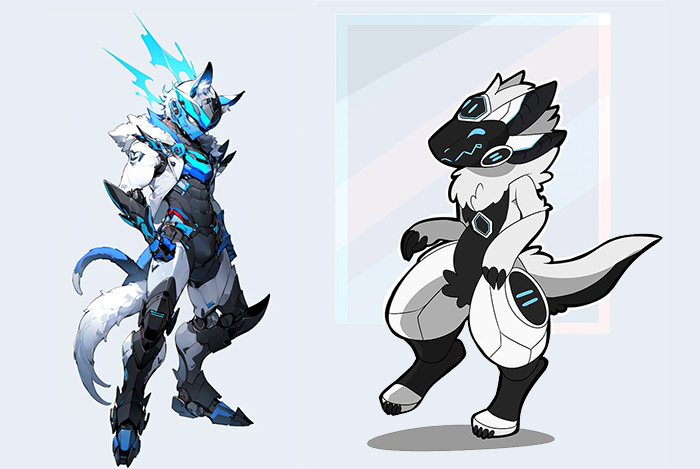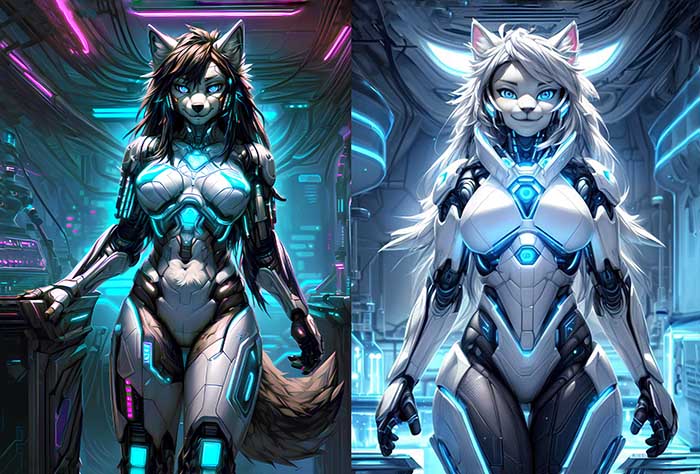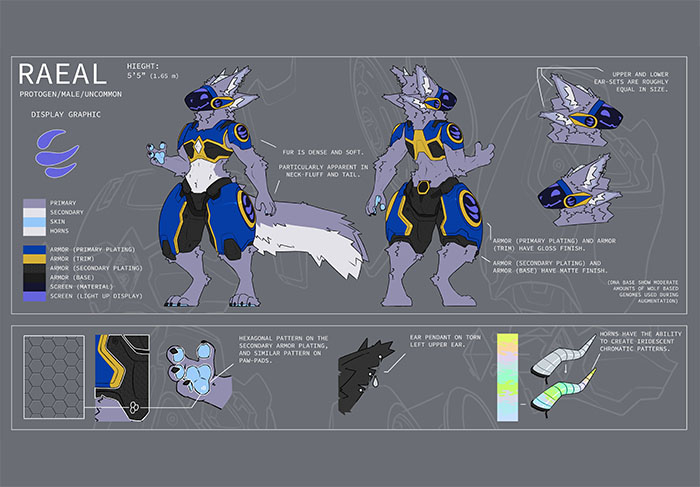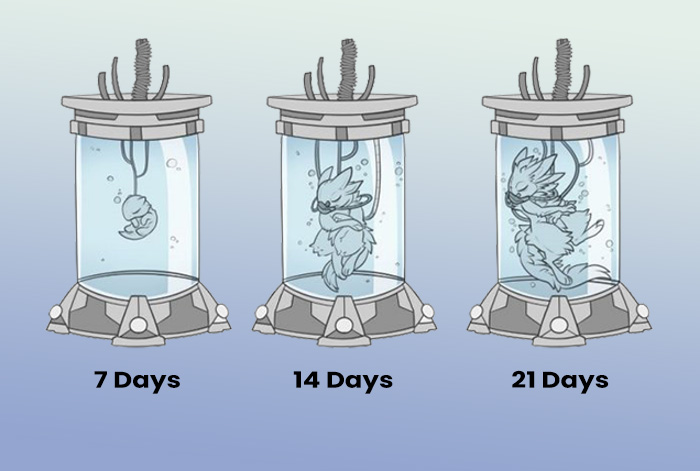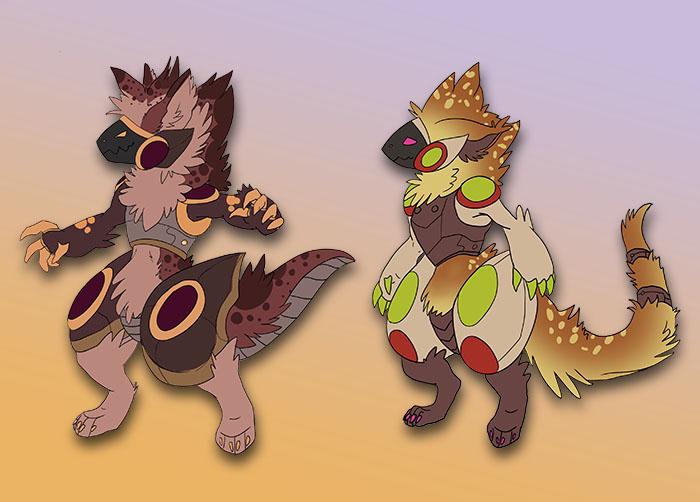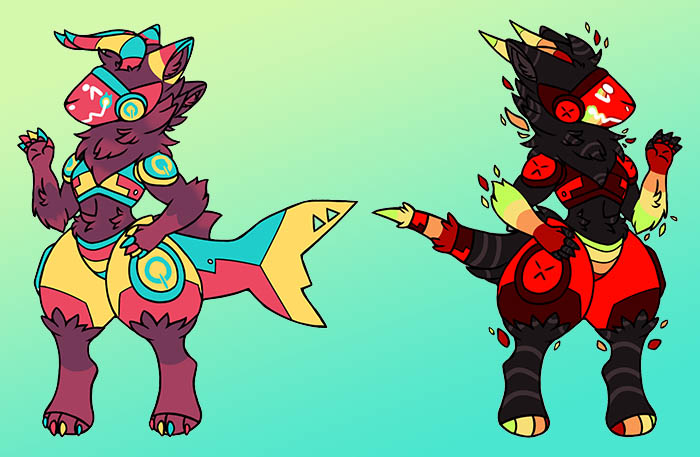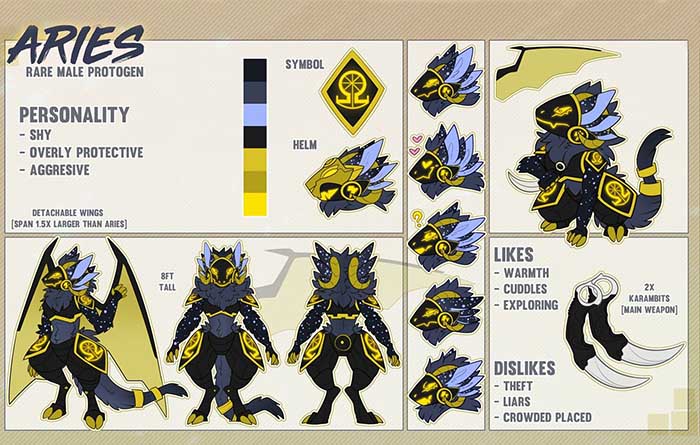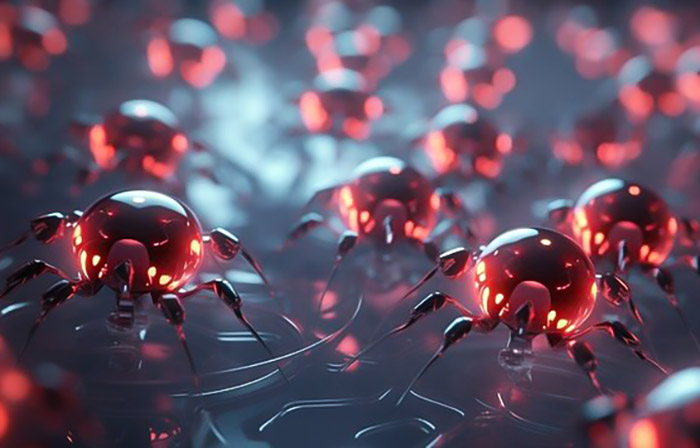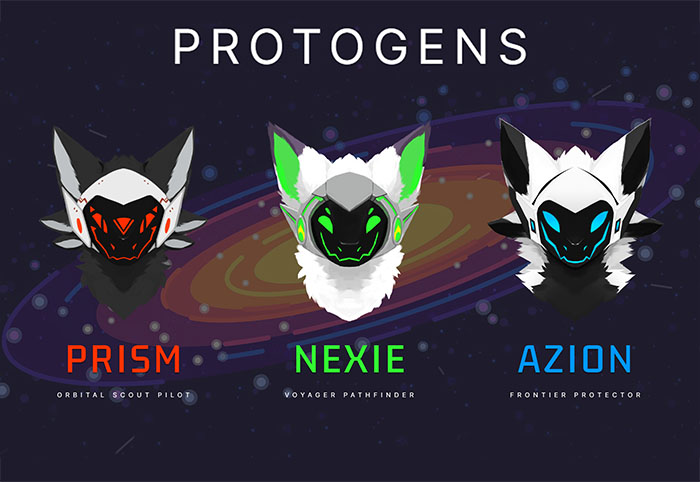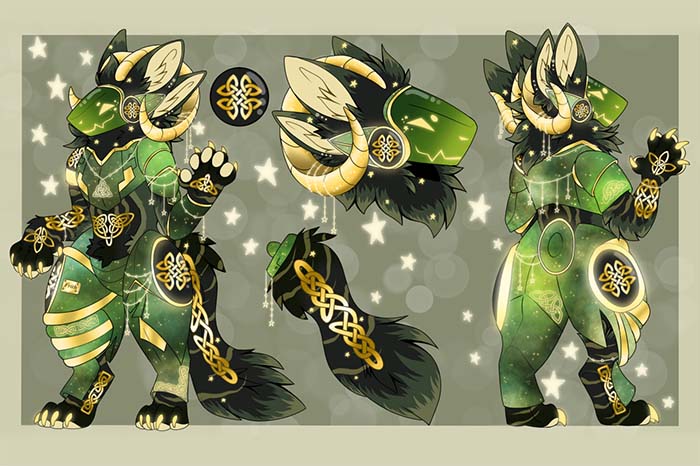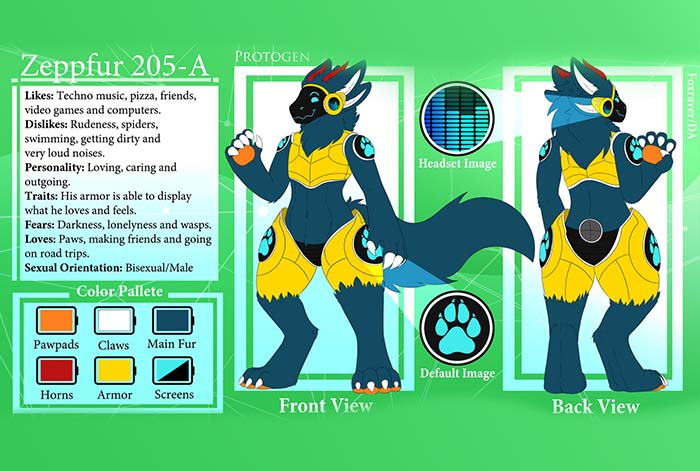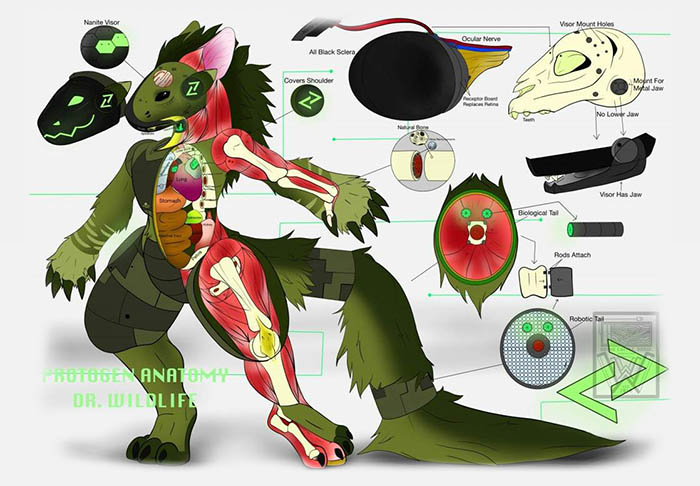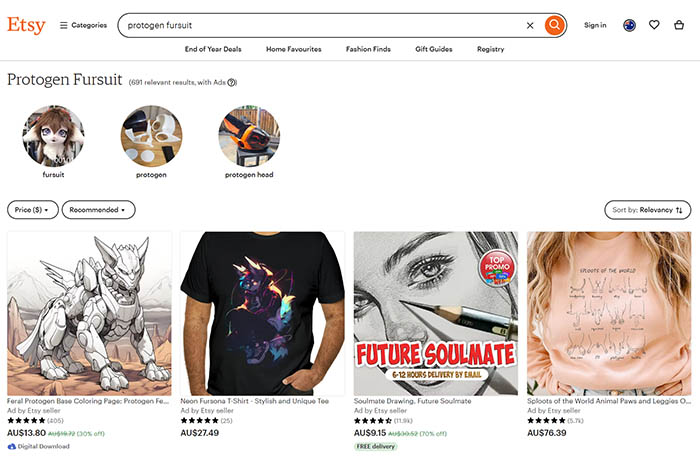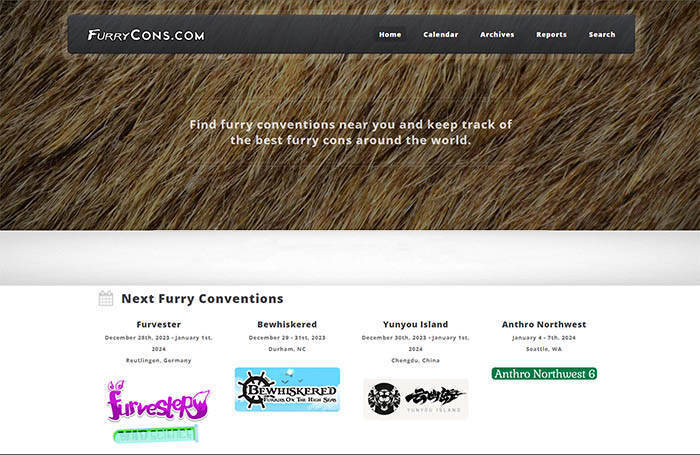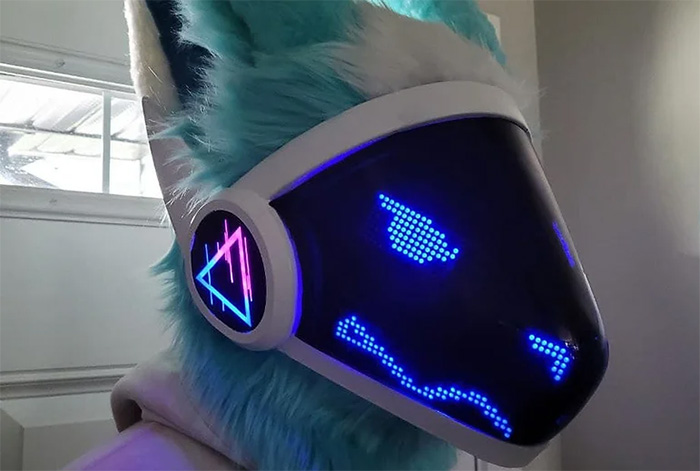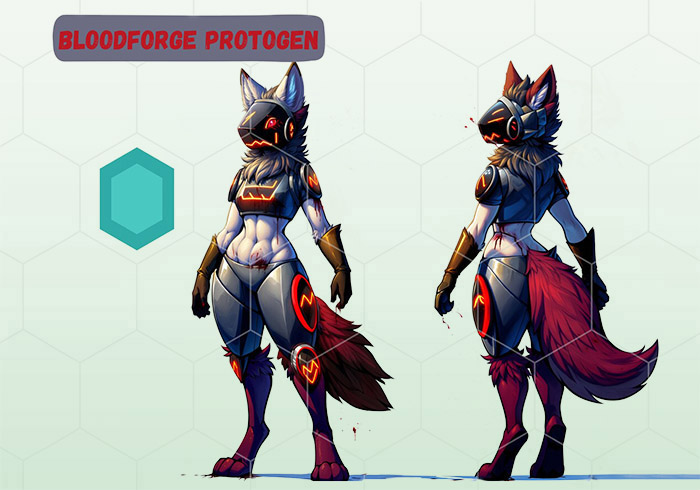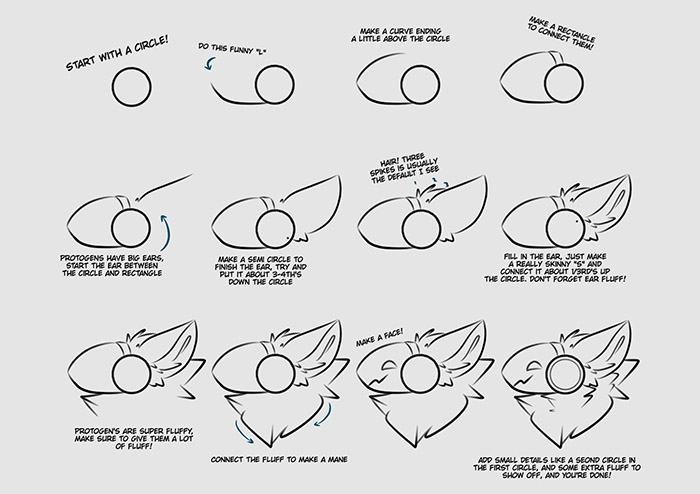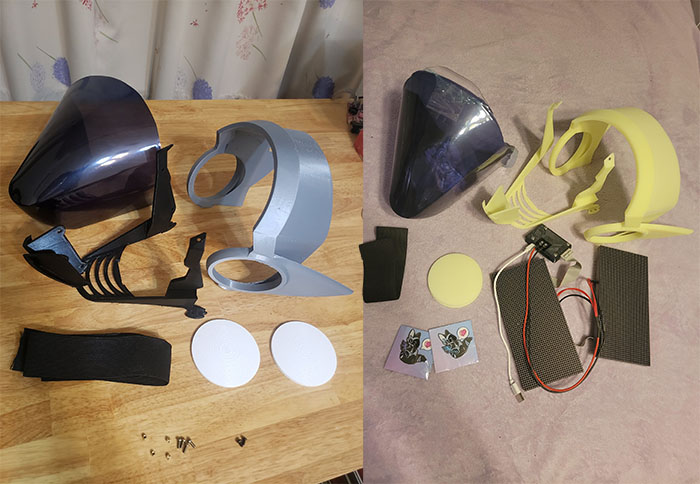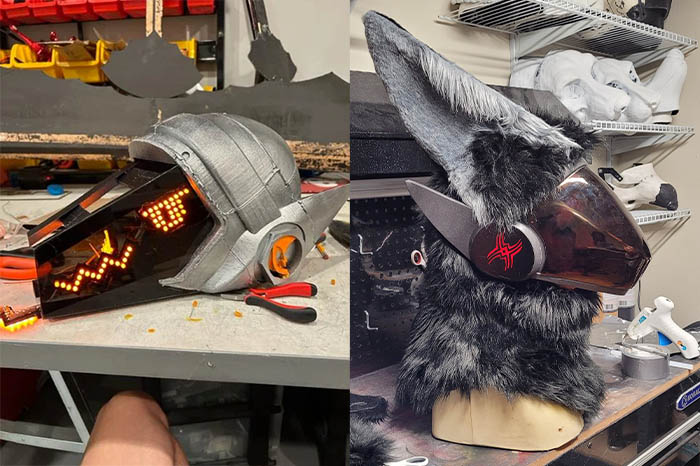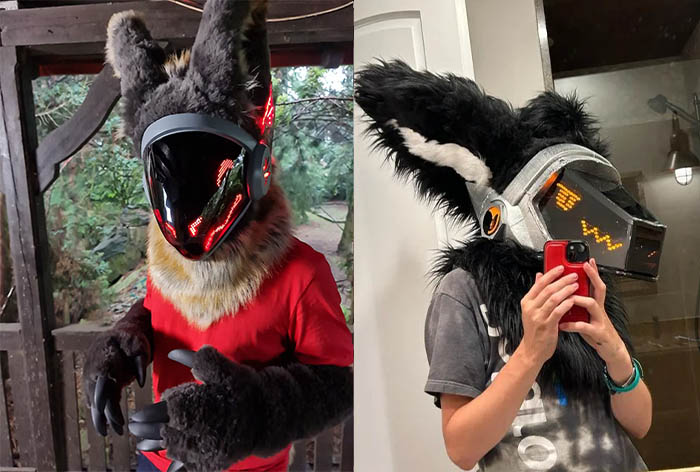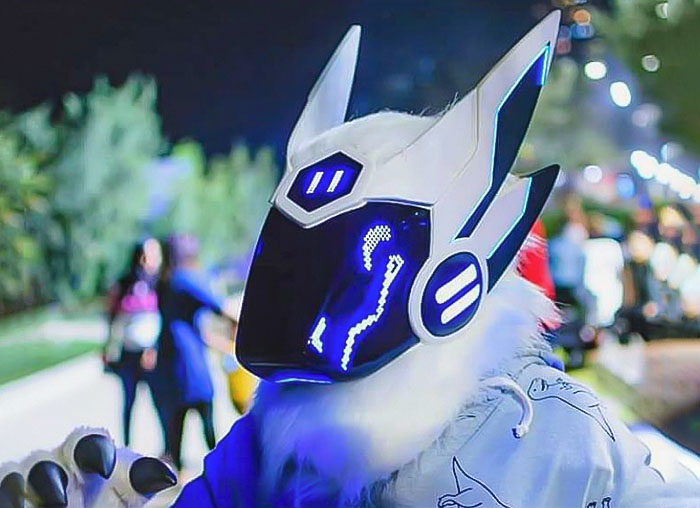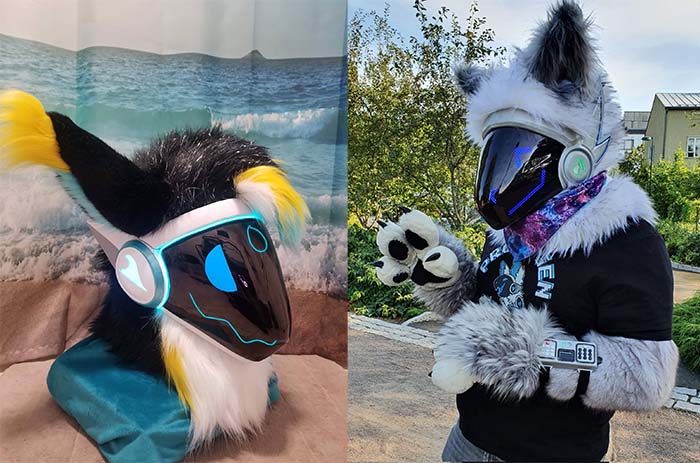Dive into the world of Protogen, the robotic furries captivating the internet! Discover their unique charm and why they’re the talk of the virtual world.
Getting to Know Protogen
Before diving into the world of “robotic furries,” let’s first get the basics down.
What is a Protogen?
In lore, Protogens are beings created by Primagens for tasks they consider too dangerous or too menial. Some lore says they were specifically made for space exploration.
Protogens are bio-cybernetic creations, their appearance a mix of organic material and machine components (often, 60 % organic, 40% machine). Their characteristics will depend on their category: Common, Uncommon, and Rare.
In reality, Protogens were made to answer the public demand to own Primagens. So, you can say that Protogens is the “public version” of Primagens. Let’s dive deeper into their origins. Continue reading below!
The Complete Lore
Alright, time to crack open the history books and delve into the creative cosmos from where Protogens and Primagens originate. In the lore, these cybernetic organisms are the brainchildren of Primagens, an advanced alien species with a high-tech itch. They’re like the “Steve Jobs” of the universe — always looking for the next big thing.
Protogens were their solution for handling tasks that were deemed either too risky or just plain tedious. Talk about smart work distribution, eh?
Primagens, on the other hand, pack a bit of an exclusive status. Their creator, Malice-Risu, earmarked them as a closed species — a sort of “members-only club” in the universe of furries if you will. They’re like the elusive, limited-edition sneakers everyone wants but only a chosen few can own.
This exclusivity sparked a public outcry, leading to the creation of Protogens, a more accessible and “public-friendly” version open to all.
Protogens: Origin Story
As they are an advanced race, Primagens wanted to create a set of sentient beings they could use to further their intelligence. The best options are those that will be able to adapt on their own and won’t need much maintenance.
Sure, artificial intelligence (AI) is good and all, but it can’t acclimate well to the ever-changing world, can it? Plus, it has no sense of self-preservation. So, what did Primagens do? They turn to biology and cybernetics.
Protogen’s DNA
There is limited information on what the Synapsid species from Reddus Nebula is capable of, but Primagens extracted DNA there that they used to create Protogens. Why? Because the DNA can make anything highly adaptable to most environments — that’s the most the Primagens will ever share.
Through the DNA they extracted, the Primagens started to work on their aimed sentient beings. After getting the appropriate DNA, Primagens started Project Artificial Remote Control (ARC). How? By injecting Protogens “Arcaites” — think of it as the ultimate “brainwashing fluid.”
Primagens relied on it to control and dominate their new creation. The Protogen DNA is now ready to be cloned via incubators.
Protogen’s Life Cycle
On average, a Protogen is “fully grown” after 21 days. The Protogen is then removed from the incubator and given their cybernetic components. Within 14 days, the Protogen’s “organic” parts are synchronized to its “artificial” augmentations. Without the synchronization, the Protogen will either tear itself apart or not function as intended.
A Protogen is only born or starts to have consciousness after direct neural input of basic functions and training.
Each Protogen DNA can be encoded or altered based on its exact usage. This alteration can also determine a Protogen’s physical (and other) capabilities depending on its purpose. Training is done in Virtual Reality, where the Protogen learns to use its limbs, write, communicate, etc.
After successful and satisfying training, they are now moved away from the production facility. Though they are sentient, Protogens are treated the same as AI. They have no individual rights and are expendable.
Protogens as a Separate Species
Some Protogens are made with more functions or augmentations. Through continuous experiments, those who had mutations fell into instability. However, this will also be the start of Primagens losing control of Protogens.
Protogen Types
Protogens fall under three categories:
Common Protogens
This category is the most basic, with Protogens akin to almost enslaved people:
· Commons have the least amount of DNA infusion.
· They are incapable of free will, making them subservient without issue.
· They are the ultimate slaves to Primagens.
· Mainly, they are assigned tasks that do not require skills.
· Because they were made during an ongoing war, they are often sent to the war zones because they are “disposable” and can be replaced with no problem.
· They can also be in a basic medical response team.
· Commons are also part of the basic construction fillers (under their superiors or creators).
Uncommon Protogens
Uncommon Protogens have more intelligence than Common Protogens. Here are more features:
· They have up to 50% DNA changed.
· They have more ears and often come with horns.
· Because they have more DNA, they have more free will.
· Uncommons are made for more “skilled” jobs.
· They can be operators of fighter jets.
· Often, they are also researchers (disease or viruses).
· Uncommons can also operate high-security details.
Rare Protogens
As the name suggests, Rare Protogens are the most special. Here’s why:
· They have at least a 50% DNA infusion rate.
· They come with more complex traits (think three ears, floating horns, multiple limp sockets, etc.)
· Often, they can break free from their Primagen owner or creator and become conscious beings of their own.
· They were made to be elite kill squads, high-value warriors, and fierce combatants, making them extremely dangerous.
· They are dangerous to their creators, the Primagens.
· Though their nanite function is more complex, Rare’s nanine is also unstable. Because of this, their bodies can disintegrate while they are still alive.
What are Nanites?
A Protogen has millions of small nanites in its whole body. The most important sense of nanites is their role in Protogens’ visors and digestion. Why? Well, Protogens still have biological parts, so they need to consume food to keep those parts working.
Protogens have tongues and throats; nanites do the rest. With the food all absorbed — nothing’s left except for gas.
“But how do they eat with that LED-like thingy on their face?” They’re not LED-thingy, nor are they glass — Protogens’ visors are nanites as well. Think of it as a facemask; it filters the bad things before Protogens inhale the air into their fully functioning respiratory system. If the visor is cracked with enough force, a Protogen can be permanently damaged or even die.
Nanites also link Protogens’ limbs and joints — they allow for sending neural data from the body parts to the brain.
Some Rare (very rare) Protogens can manipulate nanites and change their form. They can bend their nanites to be shields, for instance. Some very, very rare variants can even duplicate themselves via nanites.
The Protogen Rebellion
Protogens that had been abandoned formed small colonies in some of Esmire 4 (the Primagen’s planet) ‘s moons. Since they are deemed “worthless” and can’t do “anything,” Primagens paid them no mind. But there are Rare’s who had been training the “Arcai power” they have. It’s an ancient dimensional power the Rare’s can use to “release” other Protogens and be free. Thus, the Protogen Rebellion started.
In this war, the friction is between the Syantika versus the Nehixim factions. Syantika includes those who want to co-exist with the Protogens.
On the contrary, the Nehixim is composed of those who wanted to destroy the Protogens because they are “defective experiments” and thus need to be dealt with; after, the Nehixim members believe they should start their experimentations from scratch to avoid rebellions like this.
Protogens in E1 (one of Esmire 4’s moons) gradually created their society. Here, they are free and thus, they continue to research and master Arcai power. Eventually, the Protogens and Primagens decided to have a symbiotic relationship rather than the destruction of both species.
Owning a Protogen
Now that you know the main lore about Protogen, how can you resist having one? But first things first — there aren’t any cookie-cutter guides to having a Protogen. You’ve got to put your spin on it. Protogens are sort of a “design-your-own” type of robotic furries.
How cool is that? You can pick and choose the traits that resonate with you, pretty much like building a character in a video game. So, let’s zip through a few things you might want to know:
Personalization
Protogens are all about expressing your unique personality. Sure, you can create a whole new prototype, but you have to imbue some parts of yourself into your Protogen to make it extra special. You can customize your Protogen’s visor, limbs, and even their fluff.
So, whether you’re into neon visors, sleek metal limbs, or a hefty dose of fluffiness, there’s plenty of room for individuality.
Skillset
Protogens are made to do something. So, you should ensure your character fits the bill. The keyword here is adaptability. Need a swimmer to explore the depths of the ocean? Slap on some fins on your Protogen, then. In a jam and need a quick fix? Get those tool-laden arms in there. Versatility is their middle name.
Maintenance
A Protogen is not a one-and-done deal. They require regular upkeep. You’ll have to take care of both their tech and organic components. Please think of the how and be ready to explain how their parts work. No worries if you’re not too keen on this part. Many in the community are excited to help you along the way!
Community
Speaking of community — owning a Protogen isn’t just about the furries; it’s about being part of a vibrant and diverse community. You’re joining a global family of enthusiasts who can offer a wealth of knowledge, tips, and, of course, some good old-fashioned banter.
Owning a Protogen is a dance; it’s embracing the art of balance between tech and fluff. It’s an experience that’s part collector, part creator, and wholly unique.
Where to Buy Protogen From
Stepping into the land of Protogens might feel like you’re walking into a tech fair in a sci-fi universe — and it is! There are plenty of places to snag one of these fluffy-cum-metallic beings:
- Online Markets:
The interwebs, your one-stop shop for virtually everything, is a great starting point. Websites like Etsy or eBay often feature creators selling unique, personalized Protogens. A quick search can set you off on your Protogen acquisition adventure!
- Furry Conventions:
What better place to adopt a Protogen than a gathering of furry fanatics? Furry conventions are a hub of creativity, teeming with artists showcasing their bespoke Protogens. Not only will you get to handpick your new companion, but you’ll also become part of an exuberant community.
- Custom Orders:
If you’re all about the fundamentals and cores, custom ordering is your game. Many artists specialize in Protogens and would be thrilled to bring your vision to life. It’s a win-win situation — you get a unique Protogen, and the artist gets to flex their creative muscles!
- Protogen Adoption Agencies:
Okay, this one might sound a tad outlandish, but Protogen adoption agencies do exist! These platforms connect Protogen creators with enthusiastic adopters, ensuring every Protogen finds a loving home.
Your Protogen isn’t just something you buy — it’s your door to many more experiences you can’t even imagine! So, put on your visor and be ready for an unforgettable journey or journey to many worlds!
How to Make Protogen
Crafting your own Protogen can be as exciting as exploring uncharted galaxies! But before we jump in, remember, it’s all about injecting a little bit of your personality into your robot fluffball. So, without further ado, let’s dive into the nuts and bolts of making a Protogen.
Go Design
Before you get your hands dirty, you need a blueprint. Sketch out your Protogen, and don’t hold back on the details. From color schemes to unique markings and even the sparkle in their cybernetic eyes, this is your chance to add a personal touch. There’s no wrong design — only awesome ones!
Gather Your Materials
Once your design is ready, gather your materials. For the furry parts, faux fur is your best bet. In contrast, the visor and other metal components require a little more toughness — consider materials like resin or polycarbonate.
Think of Your Assembly Time
Start sewing the furry bits together, following your design. Meticulously piece together your Protogen’s metallic parts, ensuring they’re secure. With patience and precision, your Protogen will start taking shape. Don’t forget, Rome wasn’t built in a day!
And, of Course — Lights!
Once your Protogen is assembled, it’s time to bring it to life! Install LED lights in the visor for that sci-fi glow, and there you have it – your very own Protogen, ready to brighten up your world! Take as much time as you need when creating your Protogen. Make it with love, and it will love you back tenfold!
Conclusion
And there you have it! Your one-way ticket to the land of Protogens, where creativity and technology meet for a furry hug. Unleash your inner cyborg, don your crafting cap, and tap into the collective wisdom of this lovely community.
It might sound complicated at first, but it’s not rocket science! It’s about having fun, making connections, and welcoming the quirks of the Protogen world. And who knows? With a little elbow grease and a dollop of imagination, you might just be the next big name in the Protogen circuit.
So, go on, take the plunge. Your Protogen adventure awaits!
Protogen FAQs
What is the basic construction of a Protogen?
Protogens are typically depicted with a robotic visor displaying expressive eyes, a mechanical body with biological features such as fur, and a tail. They are a unique blend of technology and organic elements.
Can I charge a Protogen with a charger?
While Protogens are often portrayed with technological traits, they are purely imaginative creations and cannot be physically charged as you would an electronic device.
Can a Protogen have wings?
Yes, Protogens can be designed with wings. However, the physical functionality of these wings in terms of flight is left to the creator’s imagination.
Can I fly with wings?
Your Protogen can! The possibilities of your Protogen character are endless!
Can a Protogen’s mask be opened?
In lore, when you open a Protogen’s mask, you’re risking them as their visors hold the vital fluids they need to live. In character design, a Protogen’s visor or mask can be depicted as open or closed.
Can a Protogen’s limbs be removed?
In fantasy, a Protogen’s limbs can be imagined as removable or interchangeable.

